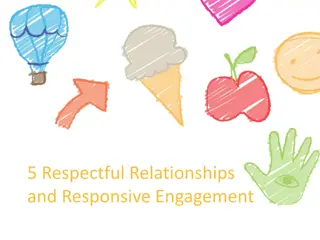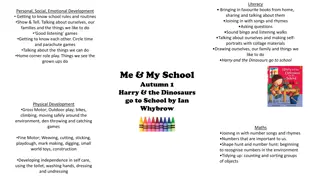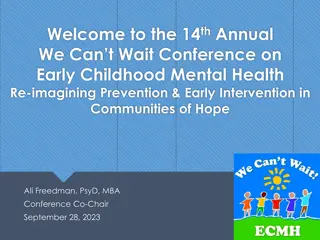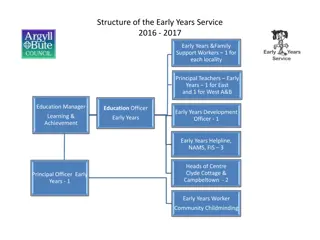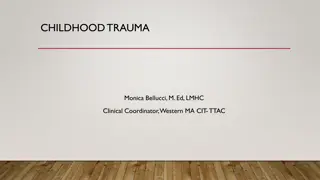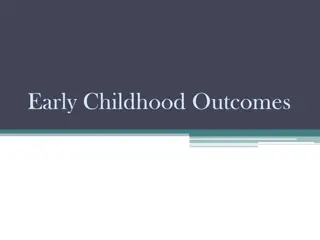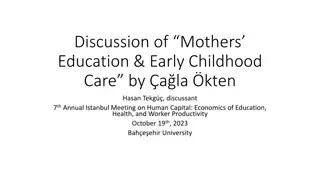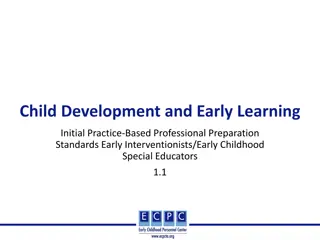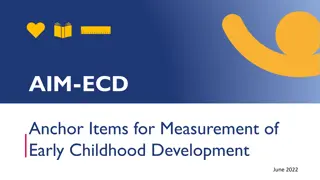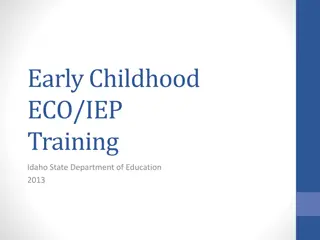The Role of Community in Early Childhood Development
Exploring the vital role of the community in the lives of children in their early years, this content emphasizes the importance of different types of communities like extended family and neighborhood relationships. It discusses how ECD centers can build partnerships within the community, highlighting initiatives such as toy libraries that provide educational and recreational benefits for children. The engagement of parents and caregivers in decision-making processes and projects at ECD centers is also emphasized to support children's learning and development.
Download Presentation

Please find below an Image/Link to download the presentation.
The content on the website is provided AS IS for your information and personal use only. It may not be sold, licensed, or shared on other websites without obtaining consent from the author. Download presentation by click this link. If you encounter any issues during the download, it is possible that the publisher has removed the file from their server.
E N D
Presentation Transcript
ECD L4 TOPIC 2 MALUTI TVET BETHLEHEM Mrs C Schnetler
The role of the community in the lives of children in the early years WE ARE ALL MEMBERS OF DIFFERENT KINDS OF COMMUNITIES AND THERE ARE DIFFERENCES IN THE TYPE OF SUPPORT OFFERED IN THESE COMMUNITIES. EXAMPLES OF COMMUNITIES: * EXTENDED FAMILY - SUPPORTIVE AND STRONG RELATIONSHIPS * NEIGHBOURHOOD RELATIONSHIPS AND SUPPORT NOT AS STRONG AS EXTENDED FAMILY. A COLLECTIVE ROLE AS COMMUNITIES ENSURE THAT THE CHILDREN OF OUR COMMUNITY ARE SAFE, WELL CARED FOR AND EDUCATED. IN THE PAST THE COMMUNITY PLAYED A MORE ACTIVE ROLE IN THE RAISING OF A CHILD. TODAY, SUPPORTIVE ROLE TO PARENTS AND CAREGIVERS IN TYPES OF SERVICES OFFERED TO FAMILIES.
The role of the community in the lives of children in the early years WHAT ECD CENTRE CAN DO TO BUILD PARTNERSHIPS IN THE COMMUNITY: * PROVIDE INFORMATION TO PARENTS ON COMMUNITY SERVICES AVAILABLE. * FORM PARTNERSHIPS WITH OTHER SCHOOLS OR ORGANISATIONS TO PROVIDE SERVICES TO FAMILIES OF ECD CENTRE COUNSELING, SPORT, RECREATION. * OPEN ECD CENTRE AFTER HOURS FOR USE BY THE COMMUNITY FOR MEETINGS. * MAKE USE OF OTHER RESOURCES - LIBRARIES, PARKS, MUSEUMS ADDING TO LEARNING EXPERIENCE OF CHILDREN. * INCLUDE PARENTS IN DECISION MAKING PROCESSES INVOLVED IN MANEGMENT OF ECD CENTRE. * INVOLVE FAMILIES AND COMMUNITY IN PROJECTS AT ECD CENTRE RECYCLING. * CONDUCT WORKSHOPS FOR PARENTS ON RELEVANT ISSUES , OFFER SUPPORT TO DEVELOP HOME ENVIRONMENT TO SUPPORT CHILD S LEARNING.
The role of the community in the lives of children in the early years TOY LIBRARIES * TOY LIBRARIES PROVIDE ACCESS TO TOYS, GAMES, PUZZLES, ACTIVITIES, EDUCATIONAL AIDS AND GENERAL PLAY EQUIPMENT. * OPEN TO FAMILIES AND CHILDREN OF ALL ABILITIES, ECD CENTRES, SCHOOLS AND YOUTH ORGANISATIONS. * TOY LIBRARIAN ASSISTS WITH CHOICE OF DIFFERENT MATERIALS TO MATCH DEVELOPMENTAL NEEDS TO CHILDREN. * CHILDREN COME TO TOY LIBRARY TO LEARN AND PLAY. * MOBILE TOY LIBRARIES VISIT COMMUNITIES. TOY LIBRARIES ARE COST EFFECTIVE TO IMPACT ON DEVELOPMENT OF YOUNG CHILDREN. THE COMMUNITY PLAYS INTEGRAL PART IN LIVES OF CHILDREN. TOY LIBRARIES ARE AN IMPORTANT PART OF THE COMMUNITY.
The role of the community in the lives of children in the early years MAIN AIMS OF TOY LIBRARIES: * EDUCATIONAL: WELL SELECTED EQUIPMENT HELP DEVELOP IMPORTANT SKILLS FOR YOUNG CHILDREN. FOCUS ON EDUCATION, BUT ALSO FUN AND ENJOYMENT. * RECREATIONAL: CHILDREN HAVE OPPORTUNITY TO INTERACT SOCIALLY. PLACE WHERE CHILDREN CAN RELAX AND BE STIMULATED MAY ASSIST IN DEALING WITH TRAUMA AND STRESS. * QUALITY OF LIFE: SERVES CHILDREN WITH SEVERE ILLNESSES IN HOSPITALS OR PLACES OF CARE AS WELL AS CHILDREN WITH SEVERE DISABILITIES, ENHANCING THEIR LEARNING AND QUALITY OF LIFE.
The role of the community in the lives of children in the early years MAIN AIMS OF TOY LIBRARIES: * PLAY IS ENCOURAGED: PLAY IS IMPORTANT PART OF DEVELOPMENT. WILL ASSIST CHILDREN TO DEVELOP PHYSICALLY, INTELLECTUALLY, SOCIALLY, EMOTIONALLY. CHIDREN LEARN THROUGH PLAY BY IMITATING, EXPLORING, INVENTING, CREATING AND PROBLEM SOLVING. ACTIVE LEARNING THROUGH PLAY. * ASSISTS LOW INCOME FAMILIES: MANY FAMILIES CANNOT AFFORD NECESSARY TOYS AND EDUCATIONAL MATERIALS. PROVIDE CHILDREN WITH OPPORTUNITY TO LEARN. PARENTS NOT AFFORDING TO SEND CHILD TO ECD CENTRE, MAY USE TOY LIBRARY AS OPPORTUNITY FOR LEARNING. * COST EFFECTIVE: PROVIDE LARGE NUMBER OF CHILDREN WITH VALUABLE LEARNING EXPERIENCES.
The role of the community in the lives of children in the early years TYPES OF TOY LIBRARIES * HOSPITAL TOY LIBRARIES: AVAILABLE TO FAMILIES WHEN CHILD IS IN HOSPITAL OR AN OUTPATIENT. TOYS NORMALLY CONTROLLED BY OCCUPATIONAL OR SPEECH THERAPIST. * TOY LIBRARIES FOR CHILDREN WITH SPECIAL NEEDS: PROVIDE SERVICE TO MENTALLY, PHYSICALLY, VISUALLY AND HEARING IMPAIRED CHILDREN. * ACTIVE LEARNING TOY LIBRARIES/ EDUCARE RESOURCE CENTRE: PROVIDE TRAINING TO VARIETY OF ECD CENTRES. SERVE COMMUNITIES WITHIN WHICH SERVICES ARE PROVIDED. * DISTRICT TOY LIBRARIES: ESTABLISHED BY DISTRICT OFFICES OF DEPARTMENT OF EDUCATION. PROVIDE SERVICE TO SCHOOLS AND ECD CENTRES. * COMMUNITY TOY LIBRARIES: SERVE GENERAL PUBLIC, INCLUDE CHILDREN OF ALL ABILITIES. NORMALLY LINKED TO PUBLIC LIBRARY OR HEALTH CLINIC.
The role of the community in the lives of children in the early years POSSIBLE QUESTIONS: 1. DISCUSS THE ROLE OF THE COMMUNITY IN THE LIVES OF CHILDREN. 2. EXPLAIN WHAT THE ECD CENTRE CAN DO TO BUILD PARTNERSHIPS IN THE COMMUNITY. 3. DEFINE TOY LIBRARY. 4. LIST AND EXPLAIN THE MAIN AIMS OF TOY LIBRARIES. 5. NAME AND DISCUSS DIFFERENT TYPES OF TOY LIBRARIES.






